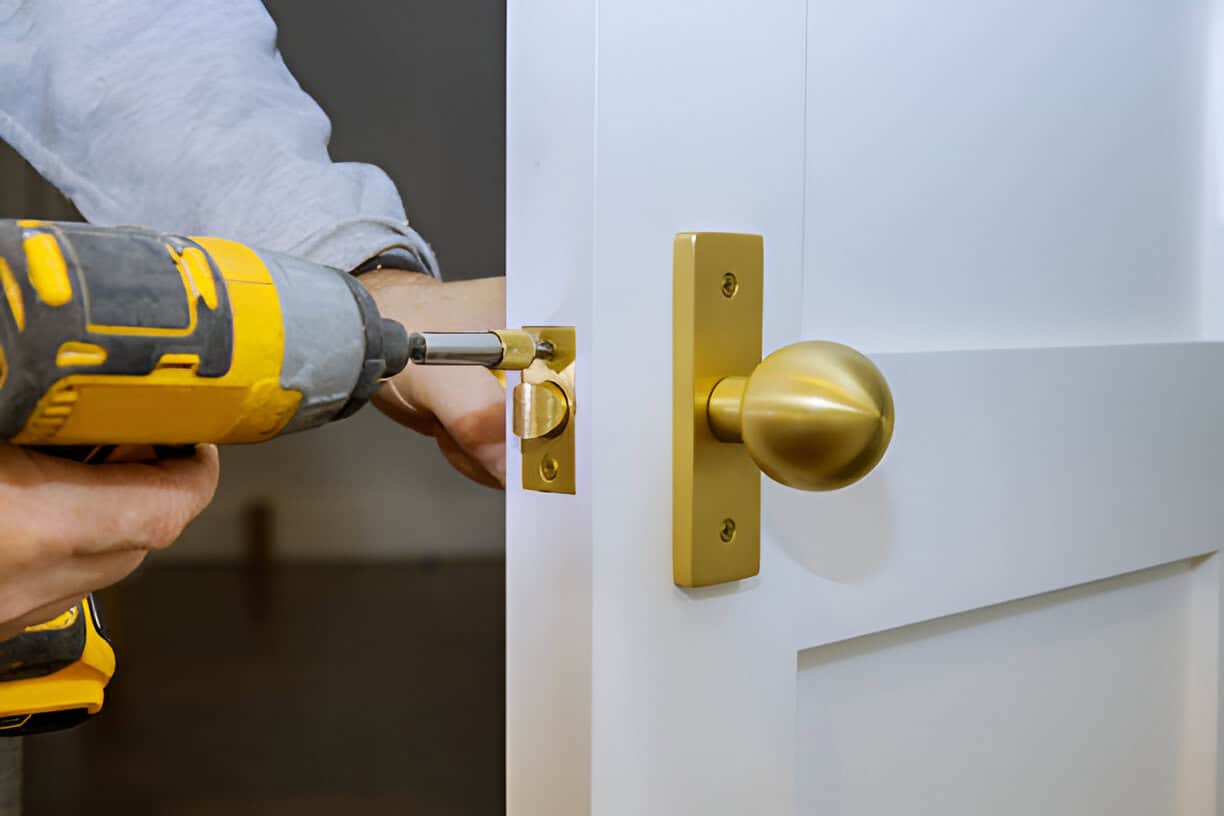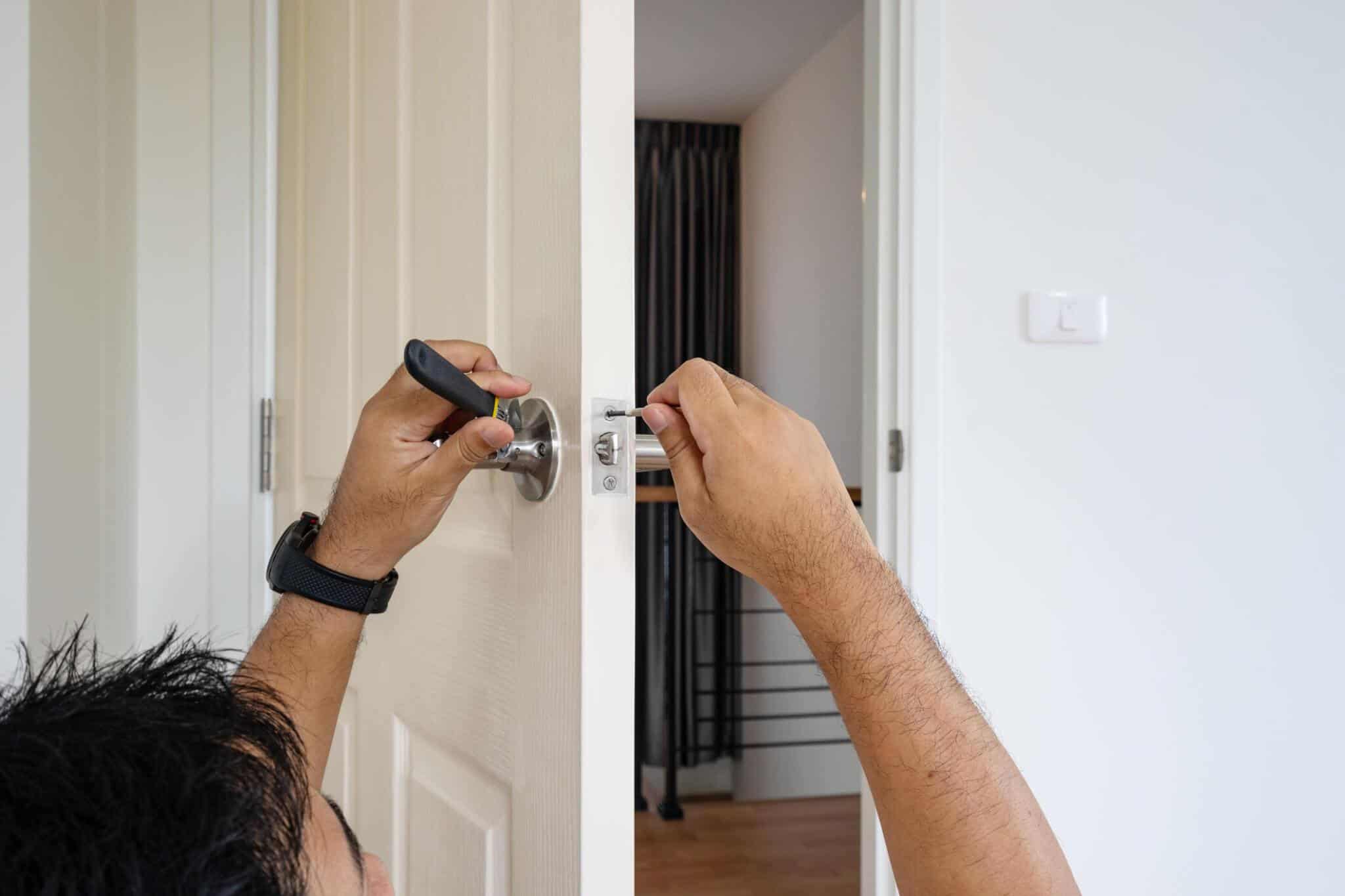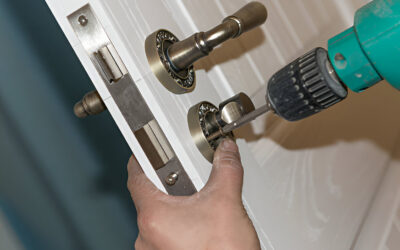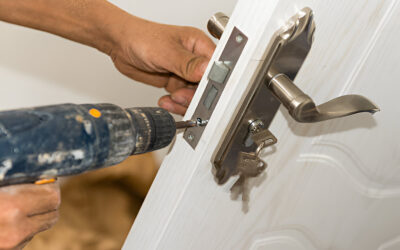Essential Tools for Removing a Lock and Handle
Before attempting to remove any door lock, having the right tools on hand is crucial. The proper tools streamline the process and prevent damage to the lock or door. Swift Locksmiths recommends the following tools:
- Phillips-head screwdriver: This is a must-have for most locks, particularly those with visible screws.
- Flat-head screwdriver: Useful for prying off components and adjusting certain lock mechanisms.
- Allen wrench set: Essential for lever handles and some mortise lock types.
- Paper clip or small nail: Perfect for engaging release mechanisms on hidden-screw locks.
- Pliers: Useful for pulling out stubborn parts or adjusting components.
- Hammer: Occasionally needed to gently loosen mortise locks embedded in door cavities.
Tips: Keep screws and small parts in a secure place, ideally a small container, to prevent misplacement during reassembly.
Understanding Different Types of Door Locks
Swift Locksmiths works with many types of locks, each with its own unique design and removal process. Knowing the type of lock you’re dealing with helps make the removal easier.
- Knob Door Locks: Common in residential homes, these locks often have visible or concealed screws and are relatively simple to remove.
- Lever Door Locks: Popular in both residential and commercial settings, these locks are favored for their easy operation and modern appearance.
- Cylinder Locks: Known for their robust security, cylinder locks are a standard choice for front doors.
- Mortise Locks: A preferred option for enhanced security, mortise locks are embedded within the door, requiring a few extra steps to remove.
How to Remove a Knob Door Lock with Visible Screws
The easiest lock to remove, visible-screw knob locks, can be taken off with minimal effort. Follow these steps for a smooth process:
- Locate the Screws: Start by identifying the screws on the rose plate (the round part attached to the door).
- Unscrew the Door Knob: Use a Phillips-head screwdriver to remove the screws.
- Remove the Knobs: Detach both the interior and exterior knobs.
- Remove the Face Plate: Unscrew and pull off the faceplate around the latch.
- Remove the Latch Mechanism: Gently pull out the latch.
- Inspect and Clean the Area: Check for dust or debris, and wipe down the area if needed.
Tips: Avoid forcing any parts if they are stuck. A gentle wiggle or light prying with a flat-head screwdriver is usually enough to free any resistant components.

How to Remove a Knob Door Lock with Hidden Screws
For knob locks with hidden screws, there’s a small release mechanism that must be activated before the knob can be removed. Here’s how:
- Locate the Slot on the Shank: Look for a small rectangular slot on the knob shank.
- Press the Release Button: Insert a paper clip or small nail into the slot to press the release button.
- Remove the Interior Knob: Once the button is engaged, pull off the interior knob.
- Pry Off the Rose Plate: Use a flat-head screwdriver to carefully pry off the rose plate.
- Unscrew the Face Plate and Remove the Latch: Detach the remaining latch mechanism by unscrewing and gently pulling it out.
How to Remove Cylinder Door Locks
Cylinder locks, often used on exterior doors, provide strong security. To remove them safely:
- Unscrew the Lock from the Interior Side: Start by removing any visible screws using a Phillips-head screwdriver.
- Turn the Spindle: Insert a flat-head screwdriver into the spindle and turn it counterclockwise.
- Press and Release the Locking Tab: Using a flat-head screwdriver, press the tab to release the cylinder.
- Remove the Cylinder: Carefully slide the cylinder out with an Allen wrench or small screwdriver.
Tips: Take care with cylinder locks as their components are sensitive. Over-twisting could damage the internal structure, making reinstallation difficult.
Removing Mortise Locks
Mortise locks are often found in older homes and require a specific removal approach. Here’s the Swift Locksmiths way:
- Locate the Set Screw on the Shank: Use a flat-head screwdriver to unscrew it.
- Unscrew Door Handles: With a Phillips-head screwdriver, unscrew the door handles.
- Detach the Rose Plates: Carefully pry off the rose plate to expose the lock’s internal parts.
- Unscrew and Remove the Face Plate: Remove the screws on the faceplate.
- Pull Out the Mortise Lock: If it’s tightly embedded, gently tap it out using a hammer and flat-head screwdriver.
Tips: Mortise locks can be tricky due to their embedded design. Be cautious, as too much force may damage both the door and the lock.
Removing Lever Door Handles (With and Without Visible Screws)
Lever door handles, a popular choice for both residential and commercial properties, require a slightly different approach based on screw visibility.
With Visible Screws
- Locate and Unscrew the Screws: Remove the screws on the handle.
- Remove the Face Plate: Unscrew the faceplate covering the latch mechanism.
- Detach the Latch Mechanism: Pull out the latch.
Without Visible Screws
- Locate the Hidden Slot: Often found along the shank.
- Depress the Latch: Use a small screwdriver or paper clip to release it.
- Remove the Lever and Rose Plate: Carefully detach the handle and rose plate.
- Unscrew Face Plate and Latch: Loosen the remaining screws.
How to Remove a Door Handle with No Screws
Some door handles are designed with fully concealed fasteners. To remove these handles:
- Find the Release Slot: Search for a small release slot on the shank of the handle.
- Press the Release Mechanism: Use a pin or small screwdriver to activate the release.
- Pull Off the Handle: Once released, gently pull the handle away.
- Pry Off the Rose Plate: Insert a flat-head screwdriver to remove the rose plate.
- Unscrew Face Plate and Remove Latch: Detach any remaining screws to free the latch.
Disassembling a Door Handle for Cleaning or Repair
Routine maintenance can prolong the life of your lock and handle. Here’s a step-by-step for disassembling:
- Remove the Exterior Knob or Lever: Loosen any screws or depress the latch to remove the exterior component.
- Detach Rose Plates: Remove both rose plates to clean underlying components.
- Pull Out the Latch Mechanism: Carefully unscrew and remove the latch.
- Clean Components: Use a mild soap solution to clean each piece, ensuring it’s thoroughly dried.
- Reassemble: Reattach parts in reverse order.
Common Issues and DIY Fixes
Swift Locksmiths frequently assists clients with common lock issues, many of which have straightforward solutions. Here’s how to handle a few of them:
- Loose Knob or Lever: Tighten any visible screws on the faceplate.
- Stuck Lock: Apply a small amount of lock lubricant to free the mechanism.
- Misaligned Lock: Adjust the strike plate or reposition the lock.
- Jammed Deadbolt: Clean and lubricate the bolt to restore smooth operation.
Frequently Asked Questions (FAQs)
Here are answers to frequently asked questions that Swift Locksmiths receives:
How do I remove a door handle with no visible screws?
Look for a hidden slot on the handle shank and use a small tool to activate the release.
What tools do I need to remove a cylinder lock?
Phillips-head screwdriver, flat-head screwdriver, and occasionally an Allen wrench.
How do I remove a mortise lock?
Unscrew the handles and faceplate, then carefully remove the mortise lock from its pocket.
What should I do if my door handle won’t turn?
Tighten loose parts, clean out debris, and apply a lubricant.
Conclusion: Why Choose Swift Locksmiths for Professional Lock Assistance
Removing a door lock or handle is manageable for most DIY enthusiasts, but not all locks are created equal. When dealing with more complex lock mechanisms or security door locks, having professional help can prevent unintended damage. Swift Locksmiths is proud to provide Melbourne residents with fast, reliable service, covering everything from lockouts and lock repairs to comprehensive security upgrades. Available 24/7, our mobile locksmith services ensure help is never far away. For inquiries, feel free to contact us at Swift Locksmiths or call 1300 100 030 to speak with our friendly team.






